|
| 
Transforming a Bay Area Brownfield Into a Green Jewel
The city of Richmond is emerging as a leader in sustainable redevelopment and in the process, preserving its past.
Story by Lisa Owens Viani
Published on Nov 6, 2017
Two decades ago, Richmond, California, was probably best known for its murder rate, poverty and industrial pollution, most famously from the Chevron refinery, which sits at the north end of the city.
In the curve of a peninsula that juts out into the northeastern shoreline of San Francisco Bay, the city has a natural deep harbor that made it the most productive World War II-era shipyard in the U.S.: 747 warships were built there, many of them by the women known as “Rosie the Riveters.” But the deepwater port also attracted chemical companies like United-Heckathorn, which profited and then left town, contaminating the harbor with persistent pesticides like DDT.
Although Chevron continues to operate, environmental cleanup continues, and poverty is still a problem in Richmond, the murder rate has fallen dramatically, and the city has become a surprising leader in the urban greening movement, recently winning platinum and gold sustainability awards for community greenhouse gas reductions and best practices.
It wasn’t always this way: Community activists and nonprofits once battled with the city to save even postage-stamp-size green spaces and remnants of creeks. But today city leaders and staff are leading a transformation from brownfields to green infill, pulling in millions of dollars from state grant programs intended to battle climate change.
The Miraflores green infill project is one of the city’s best examples of this new focus. Construction began this summer on the 14-acre brownfield and former Japanese-American-owned nursery. Tucked into a highly paved, older residential corner of the city, and hemmed in by train tracks and a freeway, the project honors the site’s history by preserving some of the old greenhouse structures, as well as the water tower and tank, and two original family homes. It also exemplifies the city’s new direction, with 80 units of affordable, solar-powered senior housing, 190 mostly market-rate condos, a 5.4-acre greenbelt that will connect to the city’s central greenway and public transit, and a rippling creek that will flow above ground for the first time in decades. Construction of the senior apartments is 48 percent complete and will be finished in May 2018. Greenbelt construction began in September and will also be complete next spring. The creek restoration will be done in summer or fall 2018.
“If people are looking for a place to live where they don’t want a car and can depend on public transit, you couldn’t find a better spot,” says Richmond Mayor Tom Butt. “This project is going to be a showcase for many reasons. One of the most important is that it highlights the history of the early 20th-century Japanese immigrant flower operations that at one point dominated that part of the city.”
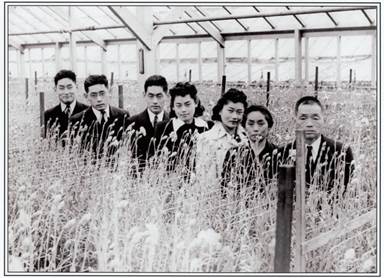
The Oishi family stands in one of their greenhouses circa 1940. (Credit: The Oishi Family Collection)
From the early 1900s to 2006, three Japanese families — Oishi, Sakai and Maida-Endo — operated a commercial rose and carnation nursery there, living in farmhouses on the site, surrounded by greenhouses, water towers, pumps, packing sheds, boiler houses, tanks and a hand-dug well that pulled water from the high groundwater table created by the creek flowing through the property. The greenhouses were lush with the scent of roses and carnations, says Flora Ninomiya, who worked in her family’s greenhouses in North Richmond and visited the Oishi, Sakai and Endo nurseries frequently. Ninomiya became closely attuned with the way the greenhouses “felt,” asking herself each day whether they need more humidity, or to be cooler, as she worked among the flowers. The Oishi, Sakai and Maida nursery operation was one of about a dozen in the Richmond area, says Donna Graves, a cultural historian who has studied Japanese-American history throughout California.
“Flower growing and truck farming were really important economic positions for Japanese immigrants,” Graves says. That would be tragically interrupted during World War II, when, like approximately 120,000 other people of Japanese descent, the Maidas, Sakais and Oishis were forcibly removed from their land and incarcerated in “internment” camps, for the sole crime of being Japanese in the United States.
Graves says she has seen and felt nothing like the sense of history on this site anywhere in the state. “This site tells such an incredible story,” Graves says. “These immigrants came here, created a life and built community, and then the racism and war hysteria forced them to relocate and be incarcerated.” But, as is true for the many other disadvantaged communities in Richmond, including the African-Americans who worked in the Kaiser shipyards during the war only to lose their jobs when white men returned from battle, the Miraflores families persevered, despite many obstacles and discriminatory policies. Many of the families leased their property to other flower growers during their incarceration, and when they returned after their internment, they successfully continued operations.
Ninomiya, who still lives in Richmond, remembers being relocated as a child to camps in Colorado with her family, where they were held for several years. As a child, she says, she was buffered by her parents from realizing the full horror of what had happened. In the early 1960s, as a young adult, she began working in her family’s greenhouses, collaborating with the Oishi, Sakai and Maida-Endo families. “The earliest settlers went to that site [now Miraflores] first and later started their own nurseries in other parts of Richmond. All of the families were very close and worked together, helping each other out when someone needed help.”
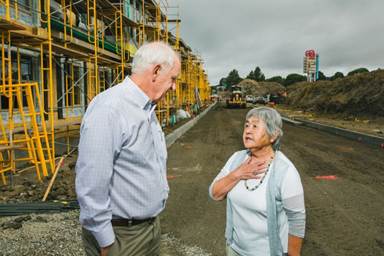
Richmond Mayor Tom Butt and Flora Ninomiya stand amid construction on the Miraflores site. (Photo by Paul Gargagliano)
Commercial flower growing in Richmond remained viable into the early 2000s, but commercial nurseries outside the U.S. had begun to outcompete them, says Graves. In 2006, the families sold the property to the city’s redevelopment agency. Like other Bay Area cities, Richmond was under a lot of pressure from state and regional agencies to build more housing — and more affordable housing.
But as was all too common before the Clean Water Act and other strong environmental regulations became law in the 1970s, lots of persistent pesticides and other chemicals had been used by the nursery — and not properly disposed of. The city discovered DDT in the soil along with petroleum hydrocarbons that had leaked from underground fuel storage tanks. Benzene and other volatile organic compounds used to clean nursery equipment were found in the groundwater. And the greenhouse structures contained lead and asbestos, which also had to be cleaned up. In 2006, the U.S. EPA awarded the Richmond Community Redevelopment Agency three brownfields cleanup grants totaling $600,000, and the state’s Pollution Control Finance Agency gave it $2.6 million in cleanup funds, with another state agency loaning a few hundred thousand more for the massive detox.
Then the project almost imploded. In 2011, the state of California dissolved redevelopment agencies in an attempt to balance a deficit budget. As part of this process, it tried to force Richmond to repay the $2.6 million in cleanup funds. But city staff fought back, says Alan Wolken, the city’s Redevelopment Agency director at the time, who ultimately got help from a state assembly member who had been raised in Richmond, and the city was able to hang onto the funding. Each grant for the project depended on the other grants to keep it moving, which meant that the loss of any one could cause the project to fail like a house of cards. This somewhat precarious financing structure has contributed to the project’s sometimes frustratingly slow pace.
What motivated the city to buy, fight so hard for, and remediate this contaminated site?
“We wanted to clean up the site to higher residential standards, knowing that it would be much better for the surrounding neighborhood than to clean it only to industrial standards,” says Wolken, who also felt that residential development would benefit the people who lived nearby much more than new industry. In addition to the $29 million from private investors raised by Eden Housing for the senior housing, the city sought out and won over $8.3 million in state grant programs funded by California’s greenhouse gas reduction cap-and-trade program. An additional $1.6 million from the state Strategic Growth Council’s urban greening fund and $500,000 from the California Coastal Conservancy are helping fund the creek restoration and greenbelt. Julie Alvis, deputy assistant secretary of California Natural Resources Agency, says, “We selected Miraflores for funding under the Urban Greening Grant Program because of its multiple benefits and strong community engagement components.”
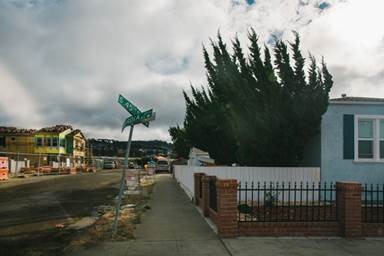
Homes line the new development. (Photo by Paul Gargagliano)
Richmond has a very long history of strong neighborhood councils, and three of them were engaged in the Miraflores project from the beginning, expressing their concerns and making the project a better one, says Wolken. Larry Oishi, a descendent of one of the three families who ran the nursery, still lives in the neighborhood and is an active member of the Park Plaza Neighborhood Council, which continues to be involved with designs for the market-rate housing that will be built next spring. Madalyn Law, chairperson of the Park Plaza Neighborhood Council, says a subcommittee from the council met every two weeks with the developers, and asked that the housing be moved much farther back from the freeway than was originally planned, which has happened. Law is relieved to see the project finally underway, after the property sat vacant for several years during the redevelopment agency crisis. She especially likes the greenbelt and envisions using it, even though she “pretty much drives everywhere now.”
“We need more open spaces for people to use instead of driving their cars,” Law says. “I hope folks will ride their bikes and walk everywhere.” Local nonprofits and other groups have also been involved in site planning — and even cleanup. RichmondBuild, a public-private partnership that teaches low-income residents construction skills, was hired to help disassemble the greenhouses, after the lead was remediated.
Although the site’s contaminated soil and water have been remediated, an ongoing source of pollution is the adjacent I-80 freeway. “In an ideal world I’d rather not build next to freeways,” says Woody Karp, senior project developer with Eden Housing, which is partnering with the Richmond-based Community Housing Development Corporation on Miraflores. “But California — and particularly the Bay Area — is experiencing a housing shortage, and because affordable housing developers cannot compete with market-rate developers, we have to take advantage of any and every opportunity we can.”
The greenbelt and urban forest are designed to mitigate impacts from the freeway, to filter and improve air quality, and even help dampen noise with an urban forest of 230 trees, according to the site’s overall project manager, Marcia Vallier, of Vallier Design Associates, another Richmond firm. The daylighted creek brings 750 feet of a long-buried stretch of waterway, Baxter Creek, above ground to become a babbling brook for residents and visitors to enjoy, continuing many citizen-initiated creek restoration projects that have taken place both upstream and downstream. Just upstream from Miraflores — on the other side of the railroad tunnel beneath the freeway — another piece of the stream is being restored. A meandering natural creek will replace an old concrete flood control channel. That property — now a pocket park along the greenway — was also a nursery, owned by the Adachis, another Japanese-American family.
The Miraflores site had one other strike against it: a long history of flooding, according to Drew Goetting with Restoration Design Group, which designed the creek restoration and greenbelt in conjunction with Vallier Design Associates. At some point, the creek had been mostly buried underground, probably to make more room for greenhouses, which made the site less able to absorb heavy rainfall. “The original plan was to daylight only 150 feet of the creek, which didn’t help much with flooding,” says Goetting. He successfully advocated for redirecting the creek so that a much longer stretch of 750 feet could be brought to the surface, and creating a riparian meadow and floodplain alongside it. To accept the creek’s reconfigured flows where it will travel beneath a street, the storm drain system to the south of the site had to be extended, an improvement the city is building.
When the I-80 freeway was built in 1948, the nurseries were fragmented and some were displaced. The greenbelt will help open the site back up again by connecting it to the Richmond Central Greenway, a 2-mile green pedestrian trail that follows the old railroad right-of-way to the north, threading through the center of Richmond and connecting with regional trails to the east (beneath the freeway) and west as well as to public transit: Bay Area Rapid Transit (BART) stations are within walking or biking distance to both the east and west. The greenway, still a work in progress, is the result of a decades-long effort led by citizen activists and 17 local nonprofits. Today it is dotted with pocket parks, community gardens, bioswales and rain gardens, like strings of green pearls along the central spine of the greenway. Many of the projects were built and are maintained by Richmond nonprofits like The Watershed Project and people who live nearby, who also bike and jog along the trail and use it to connect to public transit.
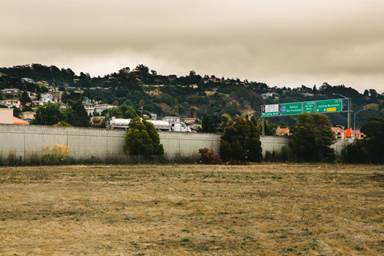
The I-80 freeway runs along Miraflores. (Photo by Paul Gargagliano)
Karp thinks connecting Miraflores to the central greenway and the rest of the community will be transformative for the surrounding community as well, and also increase property values. “Providing high-quality housing for seniors at this location will bolster the community in and of itself,” he says. “But in addition to that, there will be market-rate housing, which will add life to it, and this beautiful linear park with a cool creek that will be delightful for people to walk next to.” The “green” part of Miraflores isn’t just the greenbelt, creek and urban forest. Solar panels will offset approximately 90 percent of the common-area electric equipment requirement, says Karp, and will pre-heat the water stored in the central boiler. The panels are expected to reduce approximately 70 percent of the gas expense for heating water for the housing. Karp expects the project to be “silver” certified under a system called Green Point Rated. Next spring, the market-rate housing developer, Miraflores Community Development Company, will build 190 condominiums on the site, with 30 units set aside for moderate-income buyers. Profits from the development will help fund preservation of the site’s cultural history.
Because of its cultural significance, Miraflores may eventually be included on the National Park Service’s tours of historic sites in Richmond, along with the Rosie the Riveter memorial and Shipyard 3, which is now a California historic landmark and part of the national park system. In addition to the restored structures, interpretive signs throughout the greenbelt and at the entrances will tell the site’s story.
Ninomiya is thrilled that the site will maintain its strong sense of place and pay tribute to the Japanese-American growers. “Other than this site, there is no evidence that Japanese immigrants ever came here to the East Bay and settled and grew flowers,” says Ninomiya. She points out that in the South Bay, all of the former Japanese-American nurseries are now covered with sprawling Google, Apple and other tech headquarters — and the history of the nurseries has been obliterated.
When the property was sold to the city in 2006, Graves and representatives from the Richmond Museum of History walked through the greenhouses and other buildings to determine what could be saved. “One great ‘aha’ moment for me was finding timecards in the Sakai packing house. Most of the workers’ surnames were Spanish or Southeast Asian,” says Graves. “A place like this becomes a toehold for a new generation of immigrants from elsewhere. This property has a lot to tell us about the experience of immigrants who were discriminated against for racial reasons, and the harm that xenophobia can cause when harnessed by the federal government. But it’s also a story of perseverance, community building and resilience.” Graves says she thinks “places that grow things” have a sense of mystery and power. One mystery that remains is the origins of the site’s current name. Natalia Lawrence, who worked for the city redevelopment agency when Miraflores was in the initial planning stages, thinks planners were inspired by the fact that after the nursery had closed its doors and the land was abandoned, flowers continued to grow, even though they were no longer being cultivated. “Roses grew very persistently there for years,” she says — a poignant symbol for the site’s history.
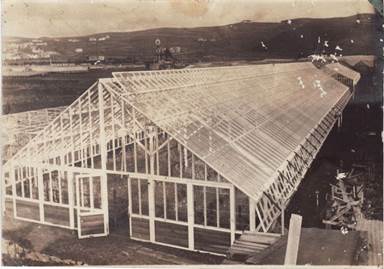
Some of the old greenhouse structures on the development site will be preserved. (Credit: The Oishi Family Collection)
The mayor sees Miraflores both as an important monument to Japanese-American history as well a showcase for the city’s new, greener focus. He credits the many local nonprofits and community members for their persistence pushing the city in a better direction.
His words seem to echo Graves’ about the resilient immigrants who once operated a flowery nursery here.
“Living in a community that has faced more challenges than many — especially the industrial pollution and discrimination — has made people more resilient here,” Butt says. “People are maybe more aware than they are in other places about how important clean air and clean water are — they are willing to work for these things knowing firsthand how their health is affected.”
|

